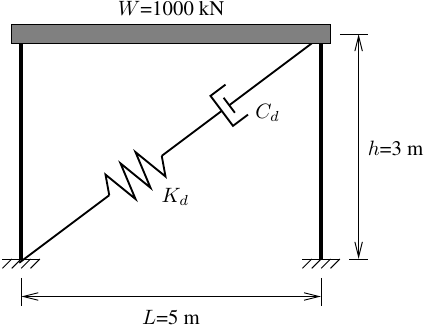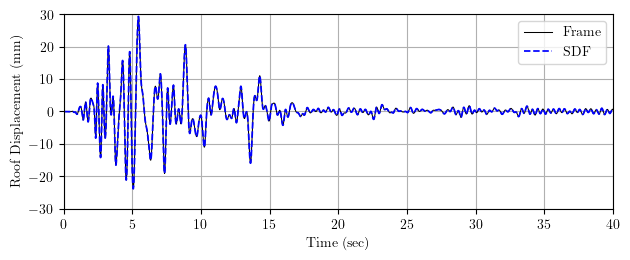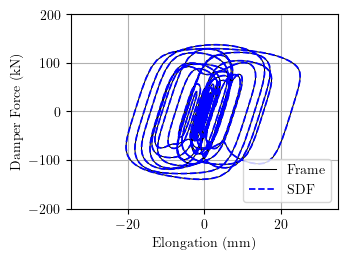OpenSees Cloud
OpenSees AMI
Minimal Damper Example
Original Post - 12 Jan 2025 - Michael H. Scott
Show your support at Buy Me a Coffee.
One of the axioms of earthquake engineering simulation is that any shear frame model can be analyzed using simple springs and masses. Even a 40-story shear frame can be economically modeled with 40 zero length elements in series.
But what happens when you add dampers to the shear frame? Do you have to start modeling the actual story heights and bay widths?
No.
Before we get to the minimal example, let’s see what could go wrong when you model a shear frame with flexural members and a damper.
Consider an often referenced viscous damper example from the OpenSees wiki.

If you look in the example Tcl file, you’ll see the frame’s lateral
stiffness, k, is calculated from the seismic weight (1000 kN) and the
target undamped natural period (0.7 sec). Nothing wrong there. But many
shenanigans ensue because the frame members are modeled explicitly with
elasticBeamColumn elements.
- The I value for the columns is calculated from k based on the story height and an assumed E value, i.e., reverse engineering the story stiffness k=2(12EI/h3) to get I=kh3/(24E).
- The I value for the beam is set to 12 orders of magnitude higher than the back-calculated I value for the column.
- The cross-sectional area, A, for the beam and the columns is set to
1e12. - An
equalDOFconstraint is imposed to make the vertical displacement and rotation of the beam nodes equal, being doubly sure the beam is flexurally rigid I suppose. - Because the beam-column elements are so artificially stiff, the
EnergyIncrconvergence test is used instead of the defaultNormUnbalance. - The analysis uses a time step of 0.001 sec. I believe this small time step was an initial attempt to mitigate the stiff element convergence issues and was never rolled back to a more reasonable 0.01 sec.
That’s a lot of work to make a portal frame respond like an SDF system.
If the point of the example was to demonstrate how to use the
ViscousDamper material, that point could easily be lost in stiff
elements, constraints, and convergence issues.
Instead, the system can be modeled in one dimension with a zero length
element for the frame in parallel with another zero length element for
the damper. The key here is that the orientation of the zero length
damper element is specified via the -orient option to be “diagonal”
based on the story height and width. Even though the model is 1D, you
can still define the direction cosine for a zero length element.
import openseespy.opensees as ops
# Units = kN, mm, sec
# Frame dimensions
L = 5000
h = 3000
# Seismic mass
W = 1000
g = 9810
m = W/g
# Natural period
Tn = 0.7
pi = 3.14159
wn = 2*pi/Tn
K = m*wn**2
# Structural damping
zeta = 0.02
C = 2*m*wn*zeta
# Damper properties
Kd = 25
Cd = 20.7452
ad = 0.35
ops.wipe()
ops.model('basic','-ndm',1,'-ndf',1)
ops.node(1,0); ops.fix(1,1)
ops.node(2,0); ops.mass(2,m)
ops.uniaxialMaterial('Elastic',1,K,C)
ops.element('zeroLength',1,1,2,'-mat',1,'-dir',1)
ops.uniaxialMaterial('ViscousDamper',2,Kd,Cd,ad)
ops.element('zeroLength',2,1,2,'-mat',2,'-dir',1,'-orient',L,h,0)
ops.timeSeries('Path',1,'-dt',0.01,'-filePath','TakY.th','-factor',0.5*g)
ops.pattern('UniformExcitation',1,1,'-accel',1,'-factor',1.0)
ops.analysis('Transient','-noWarnings')
ops.analyze(4096,0.01)
The response history of roof displacement is shown below for the stiff frame model and the minimal SDF model. The response histories are identical.

Likewise, the damper force-elongation responses shown below are identical between the two modeling approaches.

While you might say the nuances of the stiff element model are not a big deal for a single story shear frame, you will undoubtedly run into issues with this approach when modeling multi-story shear frames. Keep it simple!